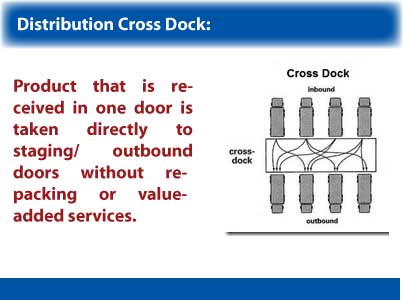Second, in some cases, it might be possible to cross dock incoming finished goods from internal or external suppliers, but timing and synchronization issues remain hard to overcome. For instance, the majority of the product a manufacturer ships to a customer will usually come from order picking with the DC. Getting that product to smoothly consolidate with product coming from trailers in the yard that contain product that might be cross docked for outbound orders is a juggling act few manufacturing companies have been able to manage.
Third, even if they could manage those timing issues, many manufacturers are leery of moving from a First In/First Out (FIFO) inventory model, especially those with expiration dates on their products. While again, in theory, rules could be developed that would minimize inventory risk from cross docking fresher product than what is sitting in storage, few companies seem to think that gamble is worth the potential labor savings.
 Other Forms of “Cross Docking” Do Succeed Other Forms of “Cross Docking” Do Succeed
While pure cross docking is difficult to make work for manufacturers, other forms of non-putaway distribution models can work.
SCDigest recently spoke with one large industrial company (a Fortune 100 member), for example, that has a strategy of only storing slow moving SKUs at plant warehouses. When orders for those products come in, they are shipped to regular distribution centers that maintain inventory of faster moving goods. As the plant shipments are received, they are stored near dock areas, and later combined with picked product from higher moving SKUs and shipped to customers, in what the company considers a “merge-in-transit” strategy.
Merge-in-transit was most famously adopted in the high-tech sector, where a manufacturer such as Dell or HP might make their own computers, but source a variety of peripherals (monitors, keyboards, etc.) from outside suppliers. The manufacturer might, for example, send its product to a 3rd party merge-in-transit center, where all of the components for a customer order would be combined.
Before Dell began to change its famous “build to order” strategy, it would call for delivery of expected peripheral needs based on that day’s forecasts from nearby supplier logistics centers that served as an inventory buffer, or direct from the supplier. As PCs came into the distribution center from manufacturing, with each machine pegged to a specific order based on its bar code, a scan would trigger the appropriate peripherals to be released onto a conveyor system, where they would be married with the PCs at packing stations.
Dave Schneider, of David K. Schneider & Associates, agrees that merge-in-transit does have some level of adoption among manufacturers.
“There are a modest number of companies that are merging manufactured product together with sourced product for combined systems,” he told SCDigest. “The goal is to have everything arrive together at the same time, combine into a single shipment and then delivered in a single shipment to the end customer.”
He added that “If it was all perfect, you could have a single shipping service provider make all of the pick-ups and merge in transit to deliver as a single drop. But life is not perfect.”
As a result, the manufacturers will attempt to have the sourced product arrive on the same day, or the day before the manufactured product is ready to ship. If the manufacturer has good control over the inbound OEM and the internal manufacturing process, then all they really need is staging space for the overnight storage of one or the other.
But getting “good control” is not easy.
“The fly in the ointment is that the “logistics” and “supply chain management” teams in manufacturing are often in two different groups,” Schneider says. “The ordering of the OEM products is left to the procurement folks, while the shipment of the manufactured products is left to the logistics folks.”
Schneider says that this usually means that there is a significant “dwell time” for the procured components. He says that one company he knows is currently attempting to get the OEM dwell time to below 10 days “average.”
We will explore additional issues with cross docking in manufacturing next week.
Can true cross docking work for manufacturers? What are the keys? Is your company making it work? We would love to hear from you. Let us know your thoughts at the Feedback button below.
SCDigest is Twittering!
Follow us now at https://twitter.com/scdigest |